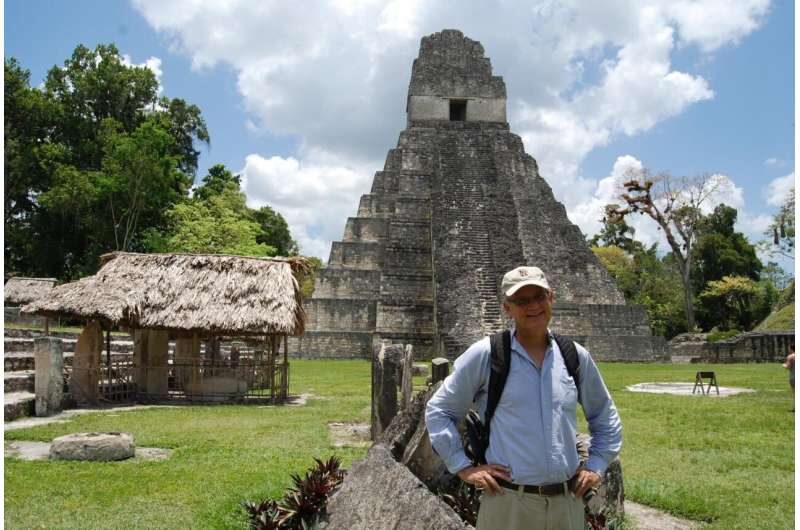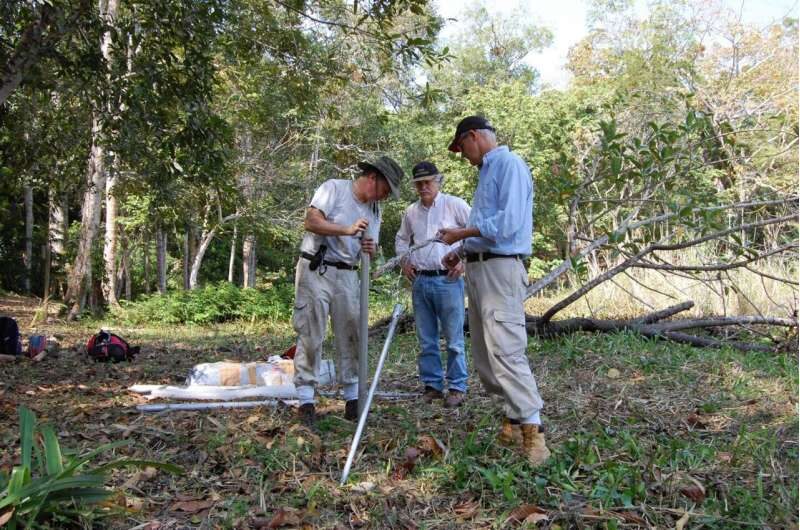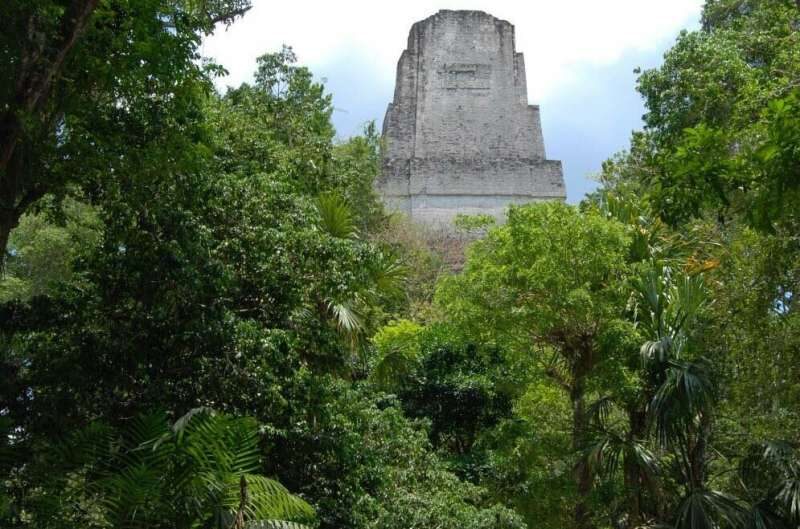
The city comprised roads, paved plazas, towering pyramids, temples and palaces and thousands of homes for its residents, all supported by agriculture.
Now researchers at the University of Cincinnati say Tikal's reservoirs — critical sources of city drinking water — were lined with trees and wild vegetation that would have provided scenic natural beauty in the heart of the busy city.
UC researchers developed a novel system to analyze ancient plant DNA in the sediment of Tikal's temple and palace reservoirs to identify more than 30 species of trees, grasses, vines and flowering plants that lived along its banks more than 1,000 years ago. Their findings paint a picture of a lush, wild oasis.
"Almost all of the city center was paved. That would get pretty hot during the dry season," said paleoethnobotanist David Lentz, a professor of biology in UC's College of Arts and Sciences and lead author of the study.
"So it would make sense that they would have places that were nice and cool right along the reservoir," he said. "It must have been beautiful to look at with the water and trees and a welcome place for the kings and their families to go."
The study was published in the Nature journal Scientific Reports.
Lentz and his research team offered four hypotheses about what, if any, plants might have grown along the all-important reservoirs: Did the Maya grow crops such as maize or squash there? Or did they plant fruit trees like those found at a similar reservoir at Mexico's Purron Dam?
Maybe they lined the reservoirs with cattails in keeping with their nickname people of the reeds? Lentz noted that water lilies often adorn ancient Maya paintings.
"Throughout Maya iconography, water lilies represent continuity between the water world and the above world," Lentz said. "It was part of their mythology."
But researchers found little evidence to support any of these hypotheses. Instead, they found evidence bolstering a fourth idea: That the Maya allowed the embankments to remain undisturbed forest. This would have helped to prevent erosion and provided medicinal or edible plants and fruits.
Researchers found evidence of a variety of plants living along the aquifers, including trees like cabbage bark and ramón that tower 100 feet high. Lentz said ramón is a dominant rainforest species in Guatemala.

Among dozens of plants native to the region, they found evidence of wild onion, fig, wild cherry and two types of grasses. Lentz said grass seeds might have been introduced to the reservoir by visiting waterfowl. Grass would have proliferated at the edges of the reservoirs during dry seasons and droughts.
"Tikal had a series of devastating droughts. As the water levels dropped, they saw blue green algae blooms, which produces toxic substances," Lentz said. "The droughts were great for the grass but not so much for the forest plants that lived along the reservoir's banks."
Were these wild areas the equivalent of a park?
"I think they were. I don't know how public they would have been," Lentz said. "This was a sacred area of the city surrounded by temples and palaces. I don't know if the commoners would have been that welcome."
Tikal was a flourishing seat of power, religion and trade for Mesoamerica in what is now northern Guatemala, reaching its peak of influence more than 1,200 years ago. Today, the cultural and archeological site is a scenic national park surrounded by primary rainforest.
But more than 1,000 years ago, the area would have looked dramatically different. Instead of rainforest, the city center would have been surrounded by homes and farm plots of corn, beans and squash needed to support 60,000 people or more. At its peak, Tikal was bigger in population than Wilkes-Barre, Pennsylvania; Atlantic City, New Jersey; or Pensacola, Florida.
Given the documented and widespread deforestation that occurred around Tikal during the city's rise and fall, the presence of an intact forest in the city would have stood out, said Nicholas Dunning, a UC geography professor and study co-author.
"It would not have been much of a park — maybe 50 meters by 50 meters," Dunning said. "But it would have been in vivid contrast to the surrounding area of the city's central precinct, which was essentially entirely paved with plaster with many of the buildings colored red."
The reservoirs would have held significance beyond their value as an important source of water, he said.
"Given that the Maya were a forest culture whose cosmology included many forest elements (for example, certain sacred trees that held up the sky) having a sacred grove adjacent to the sacred spring and pool at the heart of the city was an extremely potent symbol — kind of like parts of the cosmos in miniature," Dunning said. "On the other hand, ancient Maya cities as a whole were very green."
Tikal put today's urban gardens to shame.
"Away from the central precinct of Tikal, most of the land was either managed trees or crops," Dunning said. "Just about every household complex had significant gardens. A great deal of the food consumed by the residents of Maya cities was probably grown within the city itself or its immediate hinterland. Nothing much like a modern Western city."
Previously, researchers learned about the crops and wild plants that grew in ancient Tikal by studying ancient pollen or charcoal, Lentz said. For their study, UC turned to next-generation DNA sequencing that can identify plants and animals with even small strands of DNA.
"Typically, high-quality, high-concentration DNA is needed for next-gen work," UC botanist and study co-author Eric Tepe said. "The Tikal samples were both poor quality and very low concentration."
Microbiologists Alison Weiss, a professor in UC's College of Medicine, and Trinity Hamilton, now with the University of Minnesota, took up the task of analyzing ancient microbial DNA from the reservoir's sediment samples.
Weiss studies pathogenic E. coli and human microbiomes in her lab. Her latest work examined how chemotherapy in cancer patients impairs the protective lining of their digestive systems. But she likes all science, she said, and was eager to accept a new challenge.
"The DNA is ancient so it tends to be degraded with short little sequences," Weiss said.
With the help of the Florida company Rapid Genomics, UC's scientists developed a novel probe to select plant DNA in the sediment samples. And they were able to amplify small strands of DNA from chloroplasts, the plant structures where photosynthesis takes place. Then researchers could match the ancient Tikal samples with the DNA of known plant species in much the same way scientists amplify ribosomal DNA to identify species of bacteria.
"The analysis was quite challenging because we were the first to do this," Weiss said. "Bacterial ribosomal DNA has a database. There was no database for this. We had to take sequences one by one and search the general database to find the best match."
"This project was a bit of a shot in the dark," Tepe said. "We half-expected to get no results at all. The fact that we were able to get an idea of the vegetation surrounding the reservoirs at Tikal is, in my opinion, a spectacular success and a proof of concept that we hope to apply to other Mayan sites."
UC researchers can now study the ancient world in a promising new way.
"We're delighted we had success," Weiss said. "It took a long time to figure out how to do it and make sure it wasn't junk data in, junk data out. Now to be able to learn more about ancient people from these sediment studies is very exciting."
More information: David L. Lentz et al, Environmental DNA reveals arboreal cityscapes at the Ancient Maya Center of Tikal, Scientific Reports (2021). DOI: 10.1038/s41598-021-91620-6 Journal information: Nature , Scientific Reports




Comment: Despite clearly being aware of the value of clean water, with the Maya having invented a purification system that is known as one of the oldest and most effective in the Western hemisphere, eventually the reservoirs became so polluted with toxins that the water would have been undrinkable.
See also: